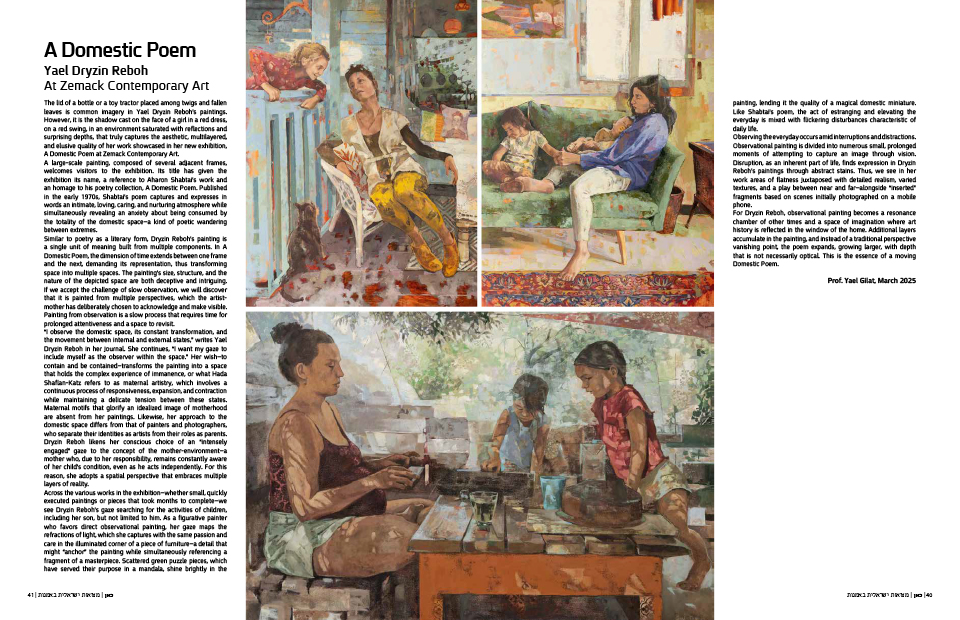
| Home Page | Editor Notices | Museums | Galleries | Publication | Donation | Contact Us |


 | |||||||||||||||
| |||||||||||||||


| |||||||||||||||
| Yael Dryzin Reboh At Zemack Contemporary Art |
The lid of a bottle or a toy tractor placed among twigs and fallen leaves is common imagery in Yael Dryzin Reboh's paintings. However, it is the shadow cast on the face of a girl in a red dress, on a red swing, in an environment saturated with reflections and surprising depths, that truly captures the aesthetic, multilayered, and elusive quality of her work showcased in her new exhibition, A Domestic Poem at Zemack Contemporary Art. A large-scale painting, composed of several adjacent frames, welcomes visitors to the exhibition. Its title has given the exhibition its name, a reference to Aharon Shabtai’s work and an homage to his poetry collection, A Domestic Poem. Published in the early 1970s, Shabtai’s poem captures and expresses in words an intimate, loving, caring, and nurturing atmosphere while simultaneously revealing an anxiety about being consumed by the totality of the domestic space—a kind of poetic wandering between extremes. Similar to poetry as a literary form, Dryzin Reboh’s painting is a single unit of meaning built from multiple components. In A Domestic Poem, the dimension of time extends between one frame and the next, demanding its representation, thus transforming space into multiple spaces. The painting’s size, structure, and the nature of the depicted space are both deceptive and intriguing. If we accept the challenge of slow observation, we will discover that it is painted from multiple perspectives, which the artist-mother has deliberately chosen to acknowledge and make visible. Painting from observation is a slow process that requires time for prolonged attentiveness and a space to revisit. “I observe the domestic space, its constant transformation, and the movement between internal and external states,” writes Yael Dryzin Reboh in her journal. She continues, “I want my gaze to include myself as the observer within the space.” Her wish—to contain and be contained—transforms the painting into a space that holds the complex experience of immanence, or what Hada Shaflan-Katz refers to as maternal artistry, which involves a continuous process of responsiveness, expansion, and contraction while maintaining a delicate tension between these states. Maternal motifs that glorify an idealized image of motherhood are absent from her paintings. Likewise, her approach to the domestic space differs from that of painters and photographers, who separate their identities as artists from their roles as parents. Dryzin Reboh likens her conscious choice of an “intensely engaged” gaze to the concept of the mother-environment—a mother who, due to her responsibility, remains constantly aware of her child’s condition, even as he acts independently. For this reason, she adopts a spatial perspective that embraces multiple layers of reality. Across the various works in the exhibition—whether small, quickly executed paintings or pieces that took months to complete—we see Dryzin Reboh’s gaze searching for the activities of children, including her son, but not limited to him. As a figurative painter who favors direct observational painting, her gaze maps the refractions of light, which she captures with the same passion and care in the illuminated corner of a piece of furniture—a detail that might “anchor” the painting while simultaneously referencing a fragment of a masterpiece. Scattered green puzzle pieces, which have served their purpose in a mandala, shine brightly in the painting, lending it the quality of a magical domestic miniature. Like Shabtai’s poem, the act of estranging and elevating the everyday is mixed with flickering disturbances characteristic of daily life. Observing the everyday occurs amid interruptions and distractions. Observational painting is divided into numerous small, prolonged moments of attempting to capture an image through vision. Disruption, as an inherent part of life, finds expression in Dryzin Reboh’s paintings through abstract stains. Thus, we see in her work areas of flatness juxtaposed with detailed realism, varied textures, and a play between near and far—alongside “inserted” fragments based on scenes initially photographed on a mobile phone. For Dryzin Reboh, observational painting becomes a resonance chamber of other times and a space of imagination where art history is reflected in the window of the home. Additional layers accumulate in the painting, and instead of a traditional perspective vanishing point, the poem expands, growing larger, with depth that is not necessarily optical. This is the essence of a moving Domestic Poem. Prof. Yael Gilat, March 2025 Read more  |
| all rights reserved - CAN ISRAELI ART REALITY |
| סייבורג מחשבים - בניית אתרים |